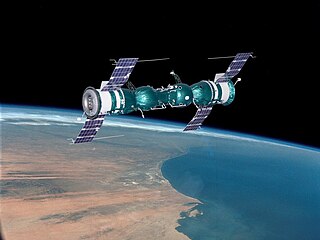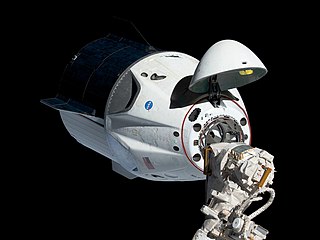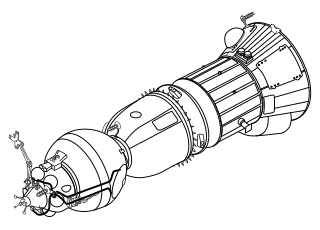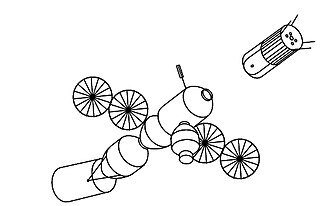
The Soyuz programme is a human spaceflight programme initiated by the Soviet Union in the early 1960s. The Soyuz spacecraft was originally part of a Moon landing project intended to put a Soviet cosmonaut on the Moon. It was the third Soviet human spaceflight programme after the Vostok (1961–1963) and Voskhod (1964–1965) programmes.

The Space Race was a 20th-century competition between two Cold War rivals, the United States and the Soviet Union, to achieve superior spaceflight capability. It had its origins in the ballistic missile-based nuclear arms race between the two nations following World War II and had its peak with the more particular Moon Race to land on the Moon between the US moonshot and Soviet moonshot programs. The technological advantage demonstrated by spaceflight achievement was seen as necessary for national security and became part of the symbolism and ideology of the time. The Space Race brought pioneering launches of artificial satellites, robotic space probes to the Moon, Venus, and Mars, and human spaceflight in low Earth orbit and ultimately to the Moon.

Soyuz is a series of spacecraft which has been in service since the 1960s, having made more than 140 flights. It was designed for the Soviet space program by the Korolev Design Bureau. The Soyuz succeeded the Voskhod spacecraft and was originally built as part of the Soviet crewed lunar programs. It is launched atop the similarly named Soyuz rocket from the Baikonur Cosmodrome in Kazakhstan.

Soyuz 3 was a spaceflight mission launched by the Soviet Union on 26 October 1968. Flown by Georgy Beregovoy, the Soyuz 7K-OK spacecraft completed 81 orbits over four days. The 47-year-old Beregovoy was a decorated World War II flying ace and the oldest person to go into orbit up to that time. The mission achieved the first Russian space rendezvous with the uncrewed Soyuz 2, but failed to achieve a planned docking of the two craft.

Soyuz 4 was launched on 14 January 1969, carrying cosmonaut Vladimir Shatalov on his first flight. The aim of the mission was to dock with Soyuz 5, transfer two crew members from that spacecraft, and return to Earth. The previous Soyuz flight was also a docking attempt but failed for various reasons.

A space rendezvous is a set of orbital maneuvers during which two spacecraft, one of which is often a space station, arrive at the same orbit and approach to a very close distance. Rendezvous requires a precise match of the orbital velocities and position vectors of the two spacecraft, allowing them to remain at a constant distance through orbital station-keeping. Rendezvous may or may not be followed by docking or berthing, procedures which bring the spacecraft into physical contact and create a link between them.

A space capsule is a spacecraft designed to transport cargo, scientific experiments, and/or astronauts to and from space. Capsules are distinguished from other spacecraft by the ability to survive reentry and return a payload to the Earth's surface from orbit or sub-orbit, and are distinguished from other types of recoverable spacecraft by their blunt shape, not having wings and often containing little fuel other than what is necessary for a safe return. Capsule-based crewed spacecraft such as Soyuz or Orion are often supported by a service or adapter module, and sometimes augmented with an extra module for extended space operations. Capsules make up the majority of crewed spacecraft designs, although one crewed spaceplane, the Space Shuttle, has flown in orbit.
The Soviet crewed lunar programs were a series of programs pursued by the Soviet Union to land humans on the Moon, in competition with the United States Apollo program. The Soviet government publicly denied participating in such a competition, but secretly pursued two programs in the 1960s: crewed lunar flyby missions using Soyuz 7K-L1 (Zond) spacecraft launched with the Proton-K rocket, and a crewed lunar landing using Soyuz 7K-LOK and LK spacecraft launched with the N1 rocket. Following the dual American successes of the first crewed lunar orbit on 24–25 December 1968 and the first Moon landing on July 20, 1969, and a series of catastrophic N1 failures, both Soviet programs were eventually brought to an end. The Proton-based Zond program was canceled in 1970, and the N1-L3 program was de facto terminated in 1974 and officially canceled in 1976. Details of both Soviet programs were kept secret until 1990 when the government allowed them to be published under the policy of glasnost.

The LK was a lunar module developed in the 1960s as a part of several Soviet crewed lunar programs. Its role was analogous to the American Apollo Lunar Module (LM). Three LK modules, of the T2K variant, were flown without crew in Earth orbit, but no LK ever reached the Moon. The development of the N1 launch vehicle required for the lunar flight suffered setbacks, and the first Moon landings were achieved by US astronauts on Apollo 11. As a result, having lost the Space Race, both the N1 and the LK programs were cancelled without any further development.
Soyuz 2A is the unofficial designation for a cancelled space flight of a Soyuz spacecraft which would have used the 7K-OK No. 5 capsule, planned to rendezvous with the Soyuz 1 mission. The launch of the craft in April 1967 was cancelled due to thunderstorms, likely saving the three-person crew from the same design problems that also killed the one-person crew of Soyuz 1.

Soyuz 7K-OK was the first generation of Soyuz spacecraft and was flown between 1967 and 1971. The 7K-OK was used for the first ferry flights to the Salyut space station program, beginning a long history of space station service that continues with the International Space Station (ISS).

The Soyuz 7K-LOK, or simply LOK was a Soviet crewed spacecraft designed to take humans from Earth to orbit the Moon, developed in parallel to the 7K-L1. The LOK would carry two cosmonauts, acting as a mother ship for the LK lander which would land one crew member to the surface. It was part of the N1-L3 programme which also included the LK lander and the N1 rocket.

Soyuz 7K-L1 "Zond" spacecraft was designed to launch cosmonauts from the Earth to circle the Moon without going into lunar orbit in the context of the Soviet crewed Moon-flyby program in the Moon race. It was based on the Soyuz 7K-OK. Several modifications reduced vehicle mass and increased circumlunar capability. The most notable modifications were the replacement of the orbital module with a support cone and a high-gain parabolic antenna, the removal of a reserve parachute, and the addition of the gyro platform and star navigation sensors for the far space navigation. The spacecraft was capable of carrying two cosmonauts. At the start of flight testing, there were serious reliability problems with the new Proton rocket, the 7K-L1, and the Soyuz 7K-OK that the L1 was based on.

Docking and berthing of spacecraft is the joining of two space vehicles. This connection can be temporary, or partially permanent such as for space station modules.

The Apollo spacecraft feasibility study was conducted by NASA from July 1960 through May 1961 to investigate preliminary designs for a post-Project Mercury multi-crewed spacecraft to be used for possible space station, circum-lunar, lunar orbital, or crewed lunar landing missions. Six-month, $250,000 study contracts were awarded to General Dynamics/Convair, General Electric, and the Glenn L. Martin Company. Meanwhile, NASA conducted its own inhouse design study led by Maxime Faget, intended as a gauge of the competitors' entries. The three companies spent varying amounts of their own money in excess of the $250,000 to produce designs which included a re-entry module separate from the mission module cabin, and a propulsion and equipment module.
Zond program was a Soviet robotic spacecraft program launched between 1964 and 1970, using two spacecraft series, one for interplanetary exploration, and the other for lunar exploration.

Soyuz 7K-L1E was a Soviet uncrewed modified Soyuz 7K-L1 spacecraft. Also called a dummy Soyuz 7K-LOK. Two were built, one Soyuz 7K-L1E was successfully launched into Low Earth Orbit on Proton rocket and is known as Kosmos 382. The other Soyuz 7K-L1E was placed on a N1 rocket, which failed at launch. The Soyuz spacecraft was first used in 1967 as the main crewed spacecraft and is still in use. Many Soyuz variations have been built and the Soyuz 7K-L1E was an uncrewed variation.

Soyuz Sever, also spelled Soyuz Siber,, was an early (1959–1962) design of the Soyuz spacecraft. The Soyuz Sever design of a crewed spacecraft started the Soyuz programme. In 1956, the Soyuz Sever spacecraft was proposed as the replacement for the Vostok spacecraft. Vostok spacecraft had only a crew of one; the Soyuz Sever plan would have crew of three. Sever was planned to be launched on a R7 rocket or Vostok rocket. The Sever plans were made by the Experimental Design Bureau (OKB-1) of the Soviet Union. While the Sever spacecraft was never built and launched, many of the designs and testing outcomes became part of the first generation Soyuz spacecraft, Soyuz 7K-OK and the Soyuz 1 mission launched on 23 April 1967. Sever final plan was to take crews to a Sever space station, OS-1962.



















